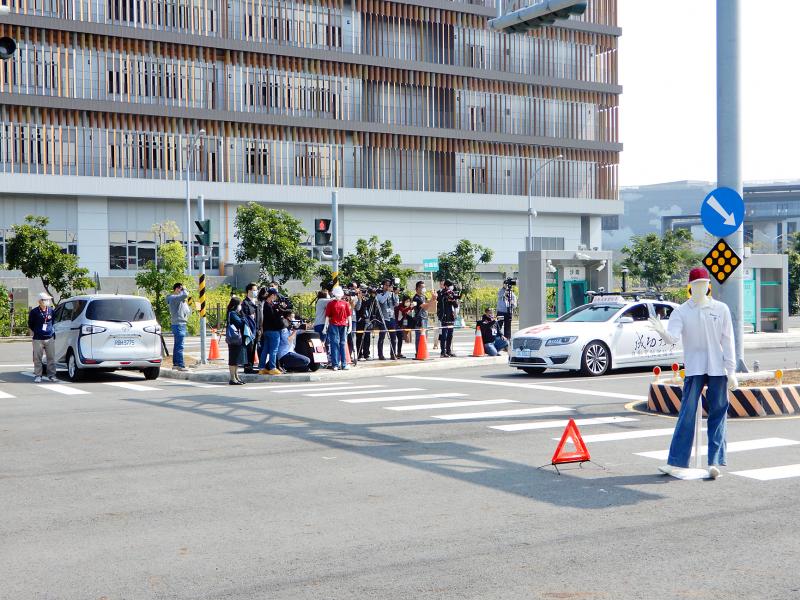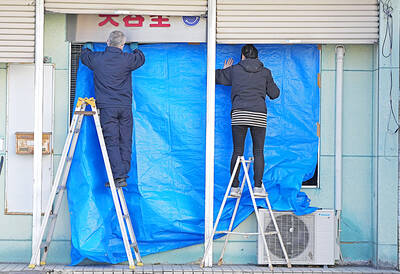Taiwan and Hungary have joined forces to promote autonomous vehicle testing, with Taiwan’s chip industry seen as bringing “added value” to the partnership, experts said.
The National Applied Research Laboratories (NARL) and Hungary’s ZalaZone on Nov. 5 signed a memorandum of understanding (MOU) via videoconference, after NARL members visited their Hungarian counterparts in 2019.
Taiwan’s first closed proving ground for self-driving vehicles, inaugurated in Tainan’s Shalun Smart Green Energy Science City in February 2019, is managed by Taiwan CAR Lab, an affiliate of the NARL.

Photo: Taiwan CAR Lab, National Applied Research Laboratories
While the site covers only 1.75 hectares, much smaller than ZalaZone’s 265 hectare proving grounds — the largest in Europe — Hungary sees potential benefits in cooperating with Taiwan.
“It is not the size that matters,” ZalaZone research and innovation head Zsolt Szalay told the Taipei Times in a video interview last month. “We can very well complement each other.”
To begin with, the two sides would exchange simulation technologies and learn from the different traffic circumstances in each country, said Szalay, an associate professor at Budapest University of Technology and Economics.
For example, there are millions of scooters in Taiwan, a different setting from Europe, he said.
To establish a sound research financing scheme, the two sides plan to improve cooperation between the Ministry of Science and Technology and Hungary’s Ministry for Innovation and Technology, and likely the Hungarian Academy of Sciences, Szalay added.
They also hope to involve the Taiwan Semiconductor Research Institute (TSRI), another unit of the NARL, as well as industrial partners developing chip and sensory technologies, he said.
“Taiwan has a traditionally very strong chip industry,” Szalay said. “Chips are appearing in more and more solutions or components for the self-driving vehicles by means of sensory systems, processing units, computers and so on, so this could also be an added value from the Taiwanese side.”
Signing the MOU is a milestone and the signatories hope to identify one or two concrete projects next year, he said.
ZalaZone has also established contact with collaborators in China, South Korea and Singapore, he added.
The MOU was inked at a time when Taiwan is improving its political and economic relations with central and eastern European countries.
Asked if the warming relations contributed to the Taiwan-Hungary cooperation, Szalay said “absolutely.”
ZalaZone is also working with partners from Germany, as well as fellow Visegrad Group members Poland, the Czech Republic and Slovakia, he said.
The bloc represents a GDP and value proposition much bigger than that of Hungary, Szalay said.
While Taiwan CAR Lab held discussions with proving grounds in France, Canada, Japan and Singapore, ZalaZone is the first to sign a deal with it, Taiwan CAR Lab deputy director Chang Lung-yao (張龍耀) said separately.
Apart from testing, ZalaZone is helping the EU establish new legislation for advanced driver assistance systems (ADAS) and self-driving vehicles, he said.
Previously, Taiwanese firms that planned to sell their products to Europe had to send components there for tests and retrieve them before further recalibration in Taiwan, he said.
Through the cooperation with ZalaZone, Taiwan would have early access to new EU legislation, allowing local firms to save costs and time when developing new automotive components, he said.
In 2020, revenue generated by Taiwan’s automotive electronics firms totaled NT$250.7 billion (US$9.05 billion at the current exchange rate), a record high and surpassing the value generated by automotive components and autos.
An average vehicle has more than 100 electronic control units, but that number is bound to increase amid soaring demand for smart vehicles, the Automotive Research and Testing Center said in a report.
Since its establishment on Feb. 25, 2019, Taiwan CAR Lab has hosted 628 tests for 20 self-driving vehicles with SAE level 3 automation, including 18 automotive electronics companies with ADAS testing, Chang said.
Research teams from National Cheng Kung University, Chimei Motor and the Industrial Technology Research Institute also tested their components and cellular vehicle-to-everything technologies at the proving ground in Shalun area (沙崙), he said.
The lab documents the tests and produces reports for users, and offers discounts to users who want to share derivative data, he added.
In Taiwan, public transport vehicles remain the staple of self-driving vehicles under development, as the cost of developing autonomous passenger vehicles is not yet affordable for individual consumers, Chang said.
Before autonomous vehicles can enter real-world settings, the transport infrastructure, such as traffic signals, should be digitized, he said.
Self-driving vehicles could be envisioned as “smartphones on wheels,” so researchers develop autonomous vehicle chips and systems based on their research and development (R&D) experience in mobile and consumer electronics, TSRI Design Service Division deputy director Chen Chi-shi (陳麒旭) said.
The division a few years ago started providing simulation software for vehicle testing, and is working with a local university to develop key technologies related to autonomous vehicle chips, as part of the government’s policy to focus on artificial intelligence chips, he said.
The division’s researchers are mainly tasked with the “proof of concept” of an advanced technique, while serving as a bridge between academia and industry before a technique can be applied in industrial settings, Chen said.
On Dec. 24, President Tsai Ing-wen (蔡英文) at the inauguration of the science ministry’s Cyber Security and Smart Technology R&D building said that smart mobility, smart healthcare and smart living would be the three main pillars of research and development at the facility, and that Shalun would become a stronghold of technology development in southern Taiwan.

Taiwanese were praised for their composure after a video filmed by Taiwanese tourists capturing the moment a magnitude 7.5 earthquake struck Japan’s Aomori Prefecture went viral on social media. The video shows a hotel room shaking violently amid Monday’s quake, with objects falling to the ground. Two Taiwanese began filming with their mobile phones, while two others held the sides of a TV to prevent it from falling. When the shaking stopped, the pair calmly took down the TV and laid it flat on a tatami mat, the video shows. The video also captured the group talking about the safety of their companions bathing

US climber Alex Honnold is to attempt to scale Taipei 101 without a rope and harness in a live Netflix special on Jan. 24, the streaming platform announced on Wednesday. Accounting for the time difference, the two-hour broadcast of Honnold’s climb, called Skyscraper Live, is to air on Jan. 23 in the US, Netflix said in a statement. Honnold, 40, was the first person ever to free solo climb the 900m El Capitan rock formation in Yosemite National Park — a feat that was recorded and later made into the 2018 documentary film Free Solo. Netflix previewed Skyscraper Live in October, after videos

Starting on Jan. 1, YouBike riders must have insurance to use the service, and a six-month trial of NT$5 coupons under certain conditions would be implemented to balance bike shortages, a joint statement from transportation departments across Taipei, New Taipei City and Taoyuan announced yesterday. The rental bike system operator said that coupons would be offered to riders to rent bikes from full stations, for riders who take out an electric-assisted bike from a full station, and for riders who return a bike to an empty station. All riders with YouBike accounts are automatically eligible for the program, and each membership account

A classified Pentagon-produced, multiyear assessment — the Overmatch brief — highlighted unreported Chinese capabilities to destroy US military assets and identified US supply chain choke points, painting a disturbing picture of waning US military might, a New York Times editorial published on Monday said. US Secretary of Defense Pete Hegseth’s comments in November last year that “we lose every time” in Pentagon-conducted war games pitting the US against China further highlighted the uncertainty about the US’ capability to intervene in the event of a Chinese invasion of Taiwan. “It shows the Pentagon’s overreliance on expensive, vulnerable weapons as adversaries field cheap, technologically